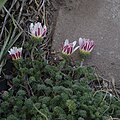Anacyclus pyrethrum
| Anacyclus pyrethrum | |
|---|---|

| |
| Mount Atlas daisy | |
| Scientific classification | |
| Kingdom: | Plantae |
| Clade: | Tracheophytes |
| Clade: | Angiosperms |
| Clade: | Eudicots |
| Clade: | Asterids |
| Order: | Asterales |
| Family: | Asteraceae |
| Genus: | Anacyclus |
| Species: | A. pyrethrum
|
| Binomial name | |
| Anacyclus pyrethrum | |
| Synonyms | |
|
Anthemis pyrethrum L. | |
Anacyclus pyrethrum, the pellitory, Spanish chamomile, Mount Atlas daisy, bertram, or Akarkara, is a species of flowering plant in the daisy family Asteraceae.[4] It is native to Mediterranean Europe and parts of North Africa, but also naturalised in other parts of Europe, India and Pakistan.[5] This herbaceous perennial resembles chamomile species in habitat and appearance.
The plants known as pellitory-of-the-wall and spreading pellitory belong to a different family, the nettles (Urticaceae).
Names
Although one might assume from the specific epithet pyrethrum that this plant contains pyrethrins, it does not.[6] Both pyrethrum and "pellitory" derive ultimately from the ancient Greek for "fire" (πῦρ).[7]
Cultivation
Anacyclus pyrethrum var. depressus (sometimes considered a separate species, Anacyclus depressus), called mat daisy or Mount Atlas daisy, is grown as a spring-blooming, low-water ornamental. It produces mats of grey-green, ferny foliage and single daisy-like white flowers. It is suitable for growing in an alpine or rock garden. It has gained the Royal Horticultural Society’s Award of Garden Merit.[8]
-
Var. depressus
-
same plant, flower detail
-
Var. depressus, flowers closed
Medicinal uses
Extracts of Anacyclus pyrethrum have anabolic activity in mice and also increase testosterone in the animal model.[9][10]
Ayurveda (the ancient Indian medicine system) and Siddha (the medical system from Tamil Nadu, a southern state of India) have uses for this plant root and it has been used for centuries as a medicine.[citation needed] It is called Akkal-Kara in Hindi, Akkal Kadha in Marathi, Akkala-karra (Telugu: అక్కలకఱ్ఱ)[11] and Akkarakaaram (Tamil: அக்கரகாரம்). A kind of oil is prepared by a method known as pit extraction (Tamil: குழி எண்ணெய்).[medical citation needed]
In The Perfumed Garden (from 15th century Tunisia), al-Nefzawi recommends pelleter taken externally as an ointment on the penis and scrotum or internally to enhance sexual pleasure and enhance erection (ch. 13, 15, 17).
References
- ^ Rankou, H.; Ouhammou, A.; Taleb, M.; Manzanilla, V. & Martin, G. (2015). "Anacyclus pyrethrum". The IUCN Red List of Threatened Species (2015). doi:10.2305/IUCN.UK.2015-4.RLTS.T202924A53798702.en.
- ^ Botanic Garden & Botanical Museum Berlin-Dahlem. "Details for: Anacyclus pyrethrum". Euro+Med PlantBase. Freie Universität Berlin. Retrieved 2008-06-16.
- ^ "Anthemis pyrethrum record n° 135636". African Plants Database. South African National Biodiversity Institute, the Conservatoire et Jardin botaniques de la Ville de Genève and Tela Botanica. Retrieved 2008-06-16.[permanent dead link]
- ^ Brickell, Christopher, ed. (2008). The Royal Horticultural Society A-Z Encyclopedia of Garden Plants. United Kingdom: Dorling Kindersley. ISBN 9781405332965.
- ^ "Anacyclus pyrethrum". Germplasm Resources Information Network. Agricultural Research Service, United States Department of Agriculture.
- ^ "pyrethrum | Definition, Description, Insecticide, & Species". Encyclopedia Britannica. Retrieved 2021-01-12.
- ^ Shorter Oxford English dictionary (6th ed.). United Kingdom: Oxford University Press. 2007. p. 3804. ISBN 9780199206872.
- ^ "RHS Plantfinder - Anacyclus pyrethrum var. depressus". Royal Horticultural Society. Retrieved 12 January 2018.
- ^ "Scientia Pharmaceutica". Archived from the original on 2011-10-03. Retrieved 2011-07-31.
- ^ Sharma, Vikas; Boonen, Jente; Spiegeleer, Bart De; Dixit, V. K. (January 2013). "Androgenic and Spermatogenic Activity of Alkylamide-Rich Ethanol Solution Extract of DC". Phytotherapy Research. 27 (1): 99–106. doi:10.1002/ptr.4697. PMID 22473789. S2CID 23573730.
- ^ "Akkala-karra; అక్కలకర, అక్కలకఱ్ఱ, అక్కలగర : శంకరనారాయణ తెలుగు-ఇంగ్లీష్ నిఘంటువు 1953".
External links
- UniProt. "Anacyclus pyrethrum". Retrieved 2008-06-16.
- M. Grieve (1931). "Pellitory". A Modern Herbal. © Copyright Protected 1995-2008 Botanical.com. Archived from the original on 9 July 2008. Retrieved 2008-06-16.
- All articles with dead external links
- Articles with dead external links from July 2017
- Articles with permanently dead external links
- Articles with short description
- Short description matches Wikidata
- IUCN Red List vulnerable species
- Articles with 'species' microformats
- All articles with unsourced statements
- Articles with unsourced statements from February 2016
- Commons category link from Wikidata
- Taxonbars with automatically added basionyms
- Anthemideae
- Medicinal plants of Africa
- Medicinal plants of Asia
- Medicinal plants of Europe



